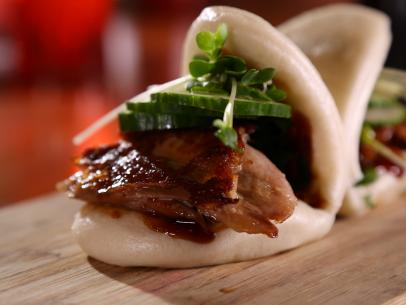
Nai Wong Bao
- Level: Intermediate
- Total: 5 hr (includes chilling and rising times)
- Active: 1 hr 30 min
- Yield: 12 bao
-
- Nutritional Analysis
- Per Serving
- Serving Size
- 1 of 12 servings
- Calories
- 180
- Total Fat
- 8 g
- Saturated Fat
- 4 g
- Carbohydrates
- 24 g
- Dietary Fiber
- 1 g
- Sugar
- 8 g
- Protein
- 4 g
- Cholesterol
- 50 mg
- Sodium
- 125 mg
- Level: Intermediate
- Total: 5 hr (includes chilling and rising times)
- Active: 1 hr 30 min
- Yield: 12 bao
-
- Nutritional Analysis
- Per Serving
- Serving Size
- 1 of 12 servings
- Calories
- 180
- Total Fat
- 8 g
- Saturated Fat
- 4 g
- Carbohydrates
- 24 g
- Dietary Fiber
- 1 g
- Sugar
- 8 g
- Protein
- 4 g
- Cholesterol
- 50 mg
- Sodium
- 125 mg
Ingredients
Custard:
Dough:
Directions
- For the custard: Fill a medium saucepan with 2 inches of water and bring to a boil. Reduce to a simmer over medium-low heat.
- Whisk together the sweetened condensed milk, cornstarch, flour, confectioners' sugar, custard powder, powdered milk, salt and eggs in a medium bowl until smooth. Strain through a fine-mesh strainer into a medium heatproof metal bowl.
- Place the bowl over the simmering water and cook, stirring constantly with a spatula and occasionally removing the bowl from the water if the custard starts to stick to the sides and whisking until mostly smooth, until the custard is thick but pourable and smooth, about 7 minutes. There may be a few curds, but they will smooth out when whisked. Whisk in the butter. Transfer to a clean medium bowl. Place a piece of plastic wrap directly on the surface of the custard and let cool in the refrigerator for at least 2 hours and up to overnight.
- For the dough: Whisk together the yeast and 1/4 cup warm water (100 to 110 degrees F) in the bowl of the stand mixer until the yeast has slightly dissolved. Set aside to proof until the surface of the water is bubbly, about 10 minutes (see Cook’s Note).
- Add the flour, milk, confectioners' sugar, baking powder and salt to the yeast mixture. Mix on low speed using the dough hook attachment until the dough starts to come together. If the dough looks dry, add an additional tablespoon of whole milk at a time until a dough forms and doesn’t stick to the sides of the bowl. Knead the dough on medium-low speed until smooth, about 8 minutes. Add the butter and knead until combined and smooth again. Cover the bowl with a dry kitchen towel and let rise in a warm place until the dough is 2 to 3 times its original size, 1 1/2 to 2 hours (see Cook’s Note).
- Meanwhile, cut twelve 4-inch parchment paper squares and set aside.
- Scoop a leveled tablespoon of the chilled custard and gently roll into a ball. Continue with the remaining custard (you should have 12 pieces). Cover with the same plastic wrap and refrigerate until needed.
- Pace the stand mixer bowl back onto the machine with the dough hook attachment and knead until the dough deflates, about 1 minute.
- Transfer the dough to a lightly floured work surface and divide into 12 pieces (about 1 ounce each). Cover the dough with a damp towel. Working with one dough piece at a time, roll out to a 4-inch circle with the edges thinner than the center. Place a custard ball in the center of the dough circle and bring the edges together to seal in the custard. Place on a parchment square and set aside. Repeat with the remaining dough and custard.
- Set up a steamer and steamer basket and fill with enough hot water to come almost up to but not touching the steamer basket. Place as many bao as you can (on the parchment squares) into the steamer basket, leaving 1 inch of space between each. Cover with a lid and let proof over the hot water until they have a puffed and glossy appearance, about 30 minutes. Let the remaining bao proof, uncovered, on the counter.
- When ready to steam, turn the heat under the steamer to medium and steam for exactly 12 minutes; start your timer when you turn on the heat. Turn off the heat and let sit for 5 minutes. Uncover the steamer and enjoy the bao hot.
- Immediately steam the remaining bao over medium heat for 12 minutes, then turn off the heat and let sit for 5 minutes.
- Freeze the cooled bao on a baking sheet in a single layer, then transfer to a freezer bag and freeze for up to 3 months. Steam from frozen for about 8 minutes, then let sit for 5 minutes. Enjoy warm fluffy bao any time you want.
Cook’s Note
If you opt to use custard powder, we recommend Lion brand, which can be found online. When measuring flour, we spoon it into a dry measuring cup and level off excess. (Scooping directly from the bag compacts the flour, resulting in dry baked goods.) Active dry yeast needs to be dissolved in warm water. If the water is too hot or too cold, the yeast will not activate. The surface of the yeast mixture should be bubbly. Proofing time can vary depending on temperature and humidity level. Always judge by size of the dough (doubling or tripling) rather than time.

































